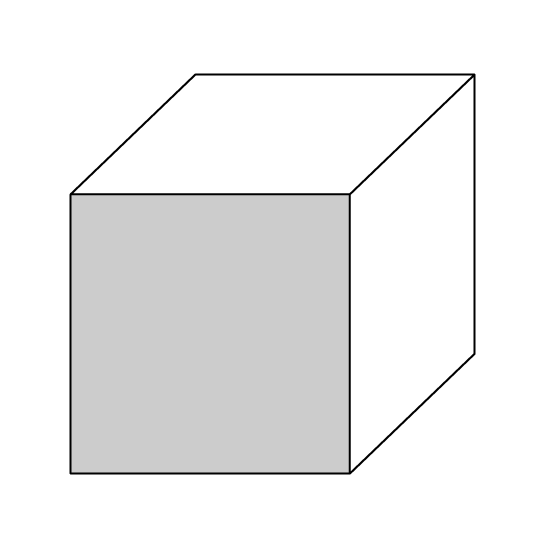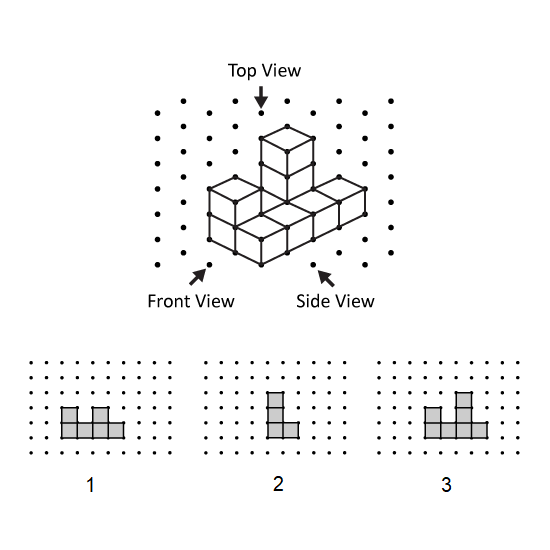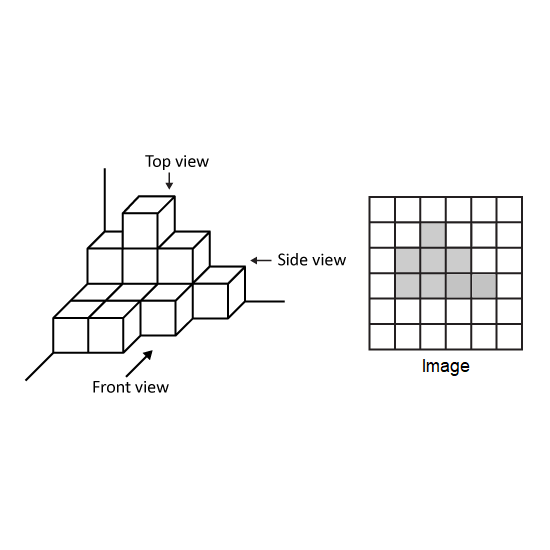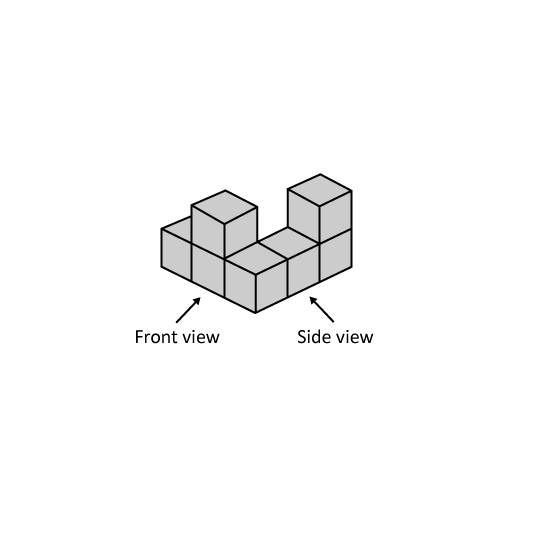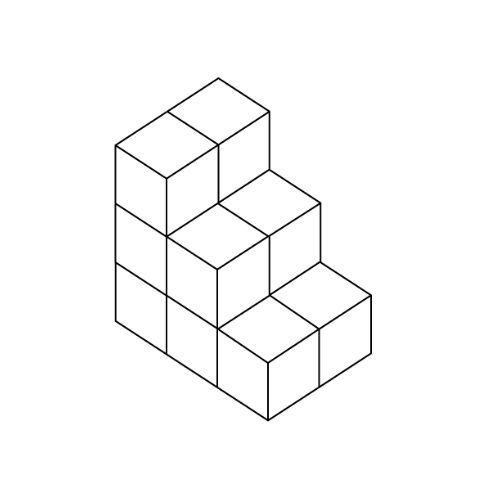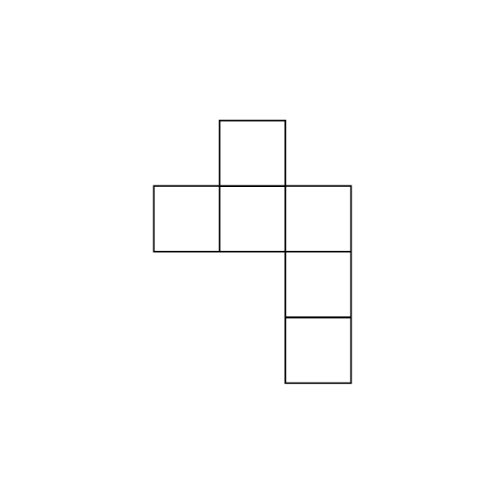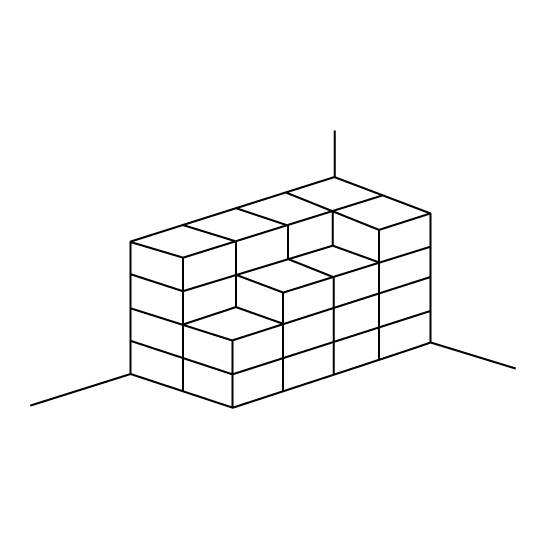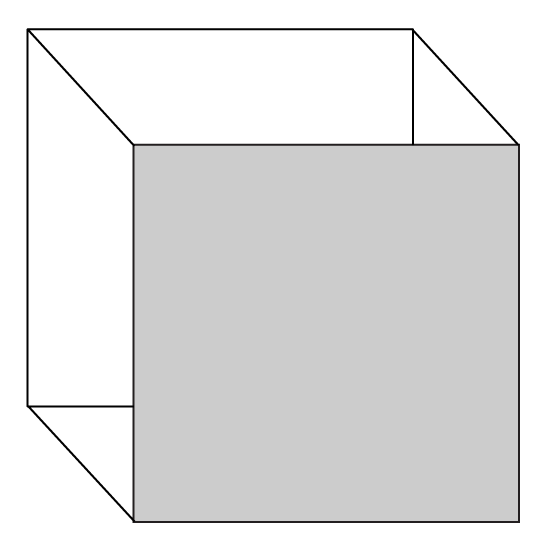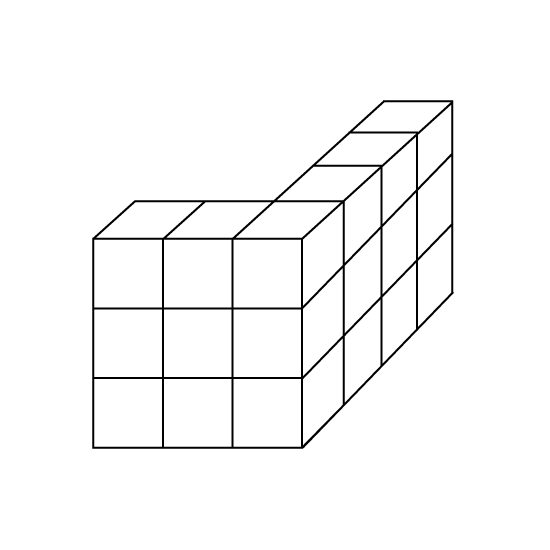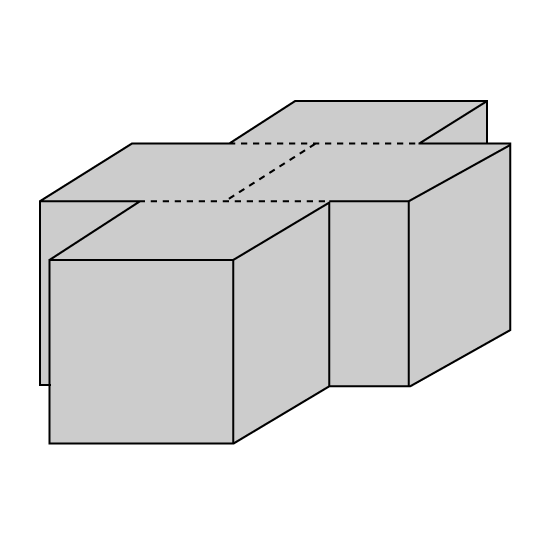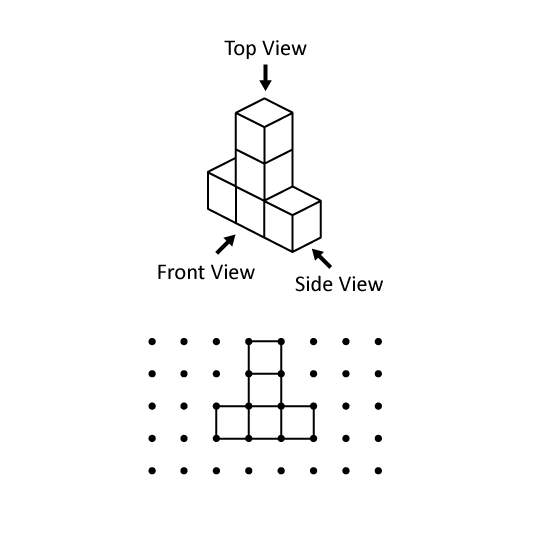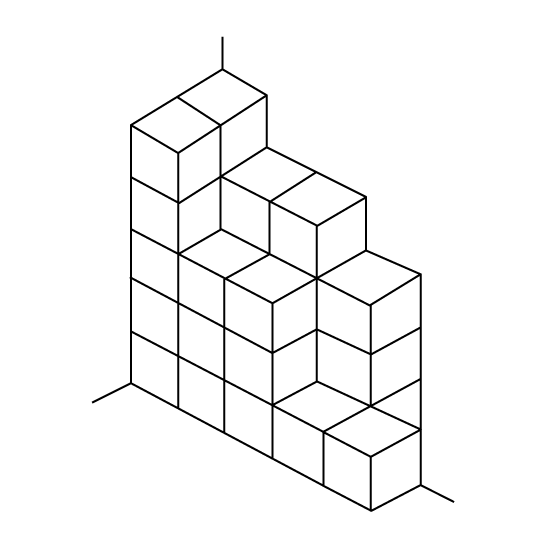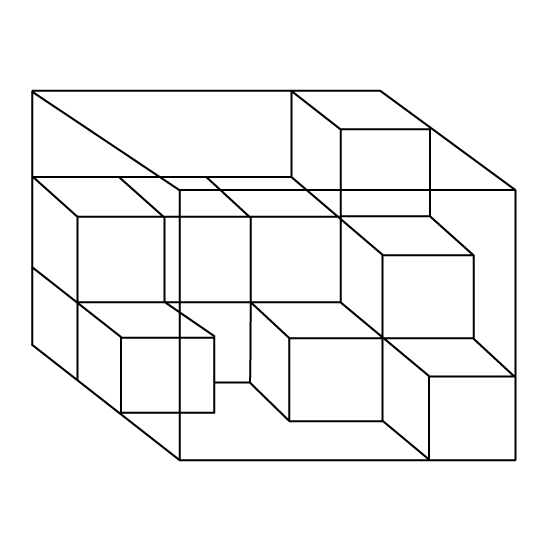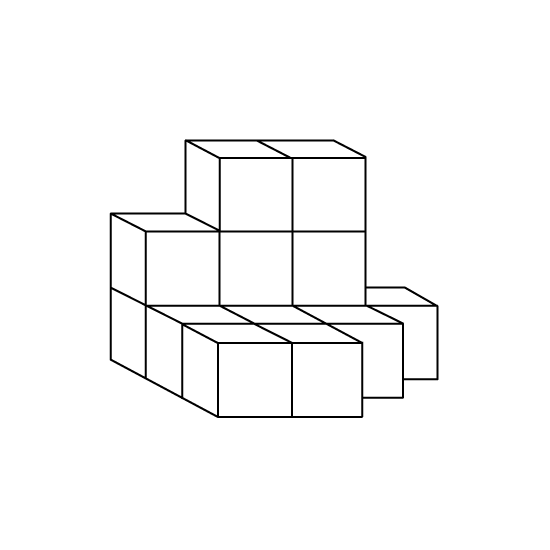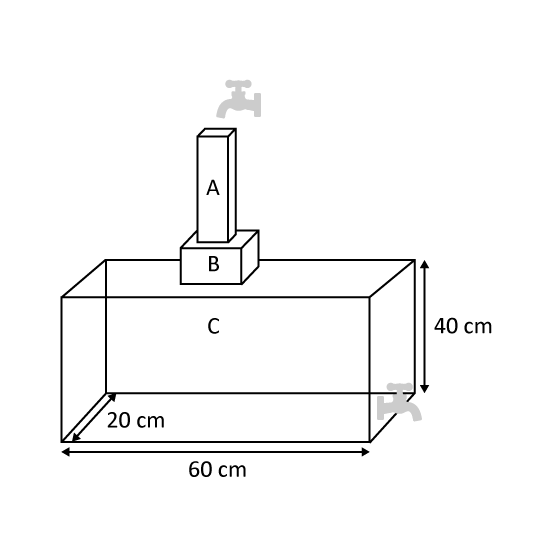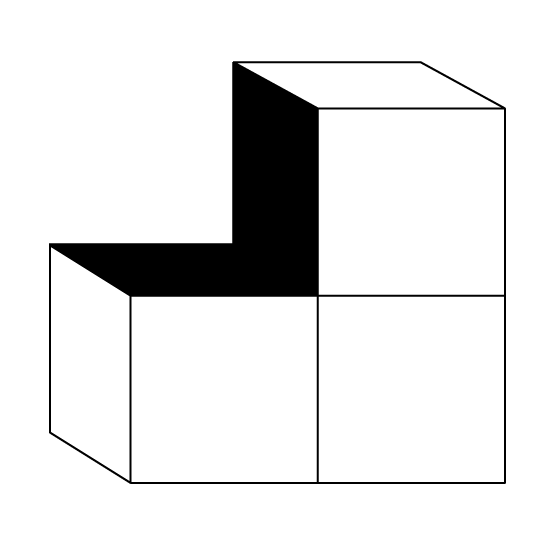Level 1 PSLE
The volume of a cube is 64 cm3. Find the perimeter of one face of the cube.
Level 1 PSLE
The volume of a cube is 64 cm3. Find the perimeter of one face of the cube.
Image in this question is not available.
Level 1 PSLE
Jim stacked 9 unit cubes and glued them together to form the solid as shown.
Which view represent the front view? Give your answer in number.
Level 1 PSLE
Jim stacked 9 unit cubes and glued them together to form the solid as shown.
Which view represent the front view? Give your answer in number.
Image in this question is not available.
Level 1
The solid is formed with unit cubes. Which view is represented by the image? Give your answer in number. (Eg 1)
(1) Top view
(2) Side view
(3) Front view
Level 1
The solid is formed with unit cubes. Which view is represented by the image? Give your answer in number. (Eg 1)
(1) Top view
(2) Side view
(3) Front view
Image in this question is not available.
Level 2 PSLE
Amy builds a solid using 7 unit cubes. Find the greatest number of unit cubes Amy can add to the solid without changing the front view and side view.
Level 2 PSLE
Amy builds a solid using 7 unit cubes. Find the greatest number of unit cubes Amy can add to the solid without changing the front view and side view.
Image in this question is not available.
Level 2 PSLE
The figure shows 12 identical cubes which are glued together to form a solid.
The whole solid, including the base, is then painted blue. How many cubes have three of their faces painted?
Level 2 PSLE
The figure shows 12 identical cubes which are glued together to form a solid.
The whole solid, including the base, is then painted blue. How many cubes have three of their faces painted?
Image in this question is not available.
Level 1 PSLE
Is the following the net of the cube? Give your answer in number. (Eg Yes = 1; No = 2)
Level 1 PSLE
Is the following the net of the cube? Give your answer in number. (Eg Yes = 1; No = 2)
Image in this question is not available.
Level 1
The figure is made up of 3-cm cubes. What is the volume of the figure?
Level 1
The figure is made up of 3-cm cubes. What is the volume of the figure?
Image in this question is not available.
Level 1
What is the maximum number of cubes of edge 6 cm that can be cut from a foam cuboid, 67 cm by 36 cm by 27 cm?
2 m
Image in this question is not available.
Level 1
The figure shows a cube. The total length of all the edges of the cube is 156 cm. Find the area of the shaded face.
Level 1
The figure shows a cube. The total length of all the edges of the cube is 156 cm. Find the area of the shaded face.
Image in this question is not available.
Level 2 PSLE Mark glued 15 cubes of side 1 cm to form the solid shown.
- Mark painted the whole solid, including the base. What was the total painted area?
- Mark added some cubes of side 1 cm to the solid to form a cuboid 3 cm by 5 cm by 5 cm. How many cubes did he add?
Level 2 PSLE Mark glued 15 cubes of side 1 cm to form the solid shown.
- Mark painted the whole solid, including the base. What was the total painted area?
- Mark added some cubes of side 1 cm to the solid to form a cuboid 3 cm by 5 cm by 5 cm. How many cubes did he add?
Image in this question is not available.
Level 2 PSLE
The block of wood shown was dipped into a pail of paint. The block was then cut into 4 identical cubes along the dotted lines and taken apart. The total unpainted area of the 4 cubes was 216 cm2. What was the volume of each cube?
Level 2 PSLE
The block of wood shown was dipped into a pail of paint. The block was then cut into 4 identical cubes along the dotted lines and taken apart. The total unpainted area of the 4 cubes was 216 cm2. What was the volume of each cube?
Image in this question is not available.
Level 2 PSLE
The solid is made up of 5 cubes.
- Which view is shown on the grid? Give your answer in number. (Eg 1)
(1) Front view
(2) Top view
(3) Side view
- Eva painted the whole solid including the base. Then she took it apart into its 5 cubes. What is the total number of faces that are not painted?
Level 2 PSLE
The solid is made up of 5 cubes.
- Which view is shown on the grid? Give your answer in number. (Eg 1)
(1) Front view
(2) Top view
(3) Side view
- Eva painted the whole solid including the base. Then she took it apart into its 5 cubes. What is the total number of faces that are not painted?
Image in this question is not available.
Level 2
The figure is made up of 1-cm cubes. How many 1-cm cubes must be added to the figure to form a larger cube of 4 cm side?
Level 2
The figure is made up of 1-cm cubes. How many 1-cm cubes must be added to the figure to form a larger cube of 4 cm side?
Image in this question is not available.
Level 2
The figure shows a rectangular glass tank partly filled with unit cubes. More unit cubes are added to fill the tank completely. What is the volume of the added cubes if each cube is a 1-cm cube?
Level 2
The figure shows a rectangular glass tank partly filled with unit cubes. More unit cubes are added to fill the tank completely. What is the volume of the added cubes if each cube is a 1-cm cube?
Image in this question is not available.
Level 2
The figure is made up of 2-cm cubes. What is the volume of the minimum number of cubes that must be added to form a bigger cube?
Level 2
The figure is made up of 2-cm cubes. What is the volume of the minimum number of cubes that must be added to form a bigger cube?
Image in this question is not available.
Level 2 PSLE
Jamie formed two cuboids with unit cubes. The length, breadth and height of the bigger cuboid are 2 times those of the smaller cuboid. She used 348 unit cubes to form the smaller cuboid.
How many unit cubes did she use to form the larger cuboid?
2 m
Image in this question is not available.
Level 3
9 identical 4-cm cubes are placed in an empty rectangular tank of length 90 cm and width 25 cm. The tank is then filled with water from a tap flowing at a rate of 7 litres per minute. It takes 12 minutes to fill up 34 of the tank. What is the height of the tank? Correct the answer to 1 decimal place.
3 m
Image in this question is not available.
Level 3
The figure shows a tank made up of 3 sections. Cuboid A with a square base of side 4 cm and height 30 cm. Cube B with a side of 12 cm. Cuboid C that is 60 cm by 20 cm by 40 cm. Water from a tap above flows down at a rate of 1.2 litres per minute while water is drained out from the bottom at a rate of 1 litre per minute. How long did it take to fill up the tank to a height of 66 cm from the base? Give the answer in minutes correct to nearest whole number.
Level 3
The figure shows a tank made up of 3 sections. Cuboid A with a square base of side 4 cm and height 30 cm. Cube B with a side of 12 cm. Cuboid C that is 60 cm by 20 cm by 40 cm. Water from a tap above flows down at a rate of 1.2 litres per minute while water is drained out from the bottom at a rate of 1 litre per minute. How long did it take to fill up the tank to a height of 66 cm from the base? Give the answer in minutes correct to nearest whole number.
Image in this question is not available.
Level 3
The figure shows a cube with 3 painted parts A, B and C. These painted parts are of the same area and they are touching the midpoints of the sides of the cube. The total area of the painted parts is 96 cm2. Find the volume of 3 such cubes.
Level 3
The figure shows a cube with 3 painted parts A, B and C. These painted parts are of the same area and they are touching the midpoints of the sides of the cube. The total area of the painted parts is 96 cm2. Find the volume of 3 such cubes.
Image in this question is not available.
Level 3
The figure is made up of identical cubes. The total area of the shaded faces is 338 cm2. Find the volume of the solid figure when we add 1 more of such cubes to it.
Level 3
The figure is made up of identical cubes. The total area of the shaded faces is 338 cm2. Find the volume of the solid figure when we add 1 more of such cubes to it.
Image in this question is not available.
